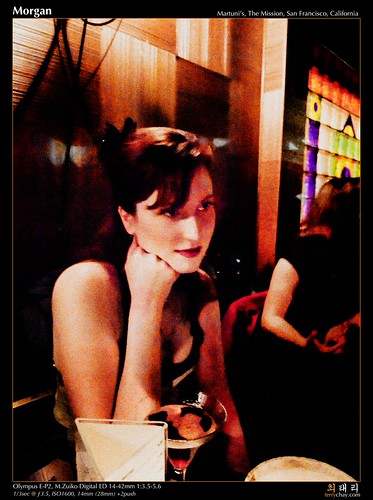My new camera takes video, but unlike my previous ones, the highest resolution video (1080p) only writes in the should-never-have-been-invented [AVCHD specification][avchd].
AVCHD has weird support on Mac OS X. If you insert a card with it, iMovie will recognize it. However, Apple Aperture and iPhoto will not. Since the video and metadata for the clips are [split over many files][file structure], you can’t do a straight import into any of the above.
While there is [an excellent free tool for viewing AVCHD video streams][vlc], this means that in order to work with this video *as a photographer*, I need to transcode the video. This was not obviously done until I ran into [this post on AVCHD on the Mac][AVCHD video workflow].
There exists many other cheaper ([and free][handbrake]) solutions for transcoding, but I opted for the more expensive [ClipWrap][clipwrap] mentioned in the article for a couple reasons:
1. Most other transcoders, re-encode the video. On the other hand QuickTime is a container format, not a codec. What ClipWrap can do is re-wrap the AVCHD in a quicktime container without changing the codec. This is much faster, but, more importantly, *it preserves the original encoding with no loss*.
2. ClipWrap can also transcode the video like other converters.
2. In both cases, ClipWrap can preserves the video creation date.
There are some caveats though:
1. A rewrapped file may not be viewable on the computer without the free tool, [Perian][perian].
2. A rewrapped file cannot be directly worked with in iMovie, instead you need to transcode into [AIC][aic]. I think you are fine if you are a Final Cut Pro user, but I stopped using that product a long time ago since I’m not a videographer.
3. Be aware of the funky file structure. Look for the videos in /PRIVATE/AVCHD/STREAM/*.MTS, not your camera’s media folder. You lose any of the other metadata also (pretty much worthless)
4. Be aware that AIC files are uncompressed more than H.264 in a ClipWrap Quicktime/AVCHD . This means you want to store it in this format, only work with it this way.
5. I don’t (yet) have a workflow for converting from rewrapped Quicktime to AIC. 🙁
This means that I store:
1. In my archive originals folder, I keep the original *.MTS files.
2. In Apple Aperture, I import re-wrapped quicktime MOVs.
3. If I need to work on videos, I transcode the AVCHD MTS’s into AIC and then import into iMovie. I lose the Aperture integration this way. 🙁
I did get it to work this way. Here’s an example I edited from the [Plantronics][plantronics] Launch Party last week:
If you don’t have video working, here are two photos I took with my other camera:

Plantronics Launch Party, Dogpatch, San Francisco, California
Nikon D3, Nikkor 24-70mm f/2.8G
1/100sec @ ƒ2.8, ISO3200, 28mm

Plantronics Launch Party, Dogpatch, San Francisco, California
Nikon D3, Nikkor 24-70mm f/2.8G
1/30sec @ ƒ3.2, ISO5000, 48mm
Now if only I can come up with a work flow for the RAW images that doesn’t involve [a lot of work][unsupported RAW] or [exiftool][exiftool] [hacking][exifhack].
…
[More photos and videos from the Plantronics Launch Party][plantronics photos].
[plantronics photos]: http://www.flickr.com/photos/tychay/sets/72157627846839069/ “2011-0138 SF Potrero Hill—Plantronics Launch Party @ Obscura Digital—tychay @ Flickr”
[exiftool]: http://www.sno.phy.queensu.ca/~phil/exiftool/ “Exiftool by Phil Harvey”
[exifhack]: http://forums.dpreview.com/forums/readflat.asp?forum=1041&message=39314992&changemode=1
[unsupported raw]: http://terrychay.com/article/unsupported-raw-apple-aperture.shtml “Unsupported RAW workflow in Apple Aperture”
[plantronics]: http://www.plantronics.com/us/ “Plantronics WIreless Heasets, Bluetooth Headset, Office and Contact Center, Enterprise Solutions”
[AVCHD video workflow]: http://echeng.com/journal/2010/07/08/avchd-hd-video-workflow-on-mac-os-x/ “AVCHD HD video workflow on Mac OS X—ECHeng”
[avchd]: http://en.wikipedia.org/wiki/AVCHD “AVCHD—Wikipedia”
[file structure]: http://en.wikipedia.org/wiki/File:AVCHD_actual_file_structure.svg “File:AVCHD actual file structure—Wikipedia”
[handbrake]: http://handbrake.fr/ “HandBrake”
[perian]: http://perian.org/ “Perian: The swiss-army knife of QuickTime components”
[clipwrap]: http://www.divergentmedia.com/clipwrap “ClipWrap”
[aic]: http://en.wikipedia.org/wiki/Apple_Intermediate_Codec “Apple Intermediate Codec—Wikipedia”
[vlc]: http://www.videolan.org/vlc/ “VideoLAN: Official page for the VLC media player: the open source video framework”













